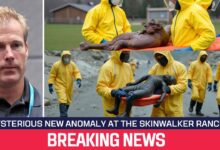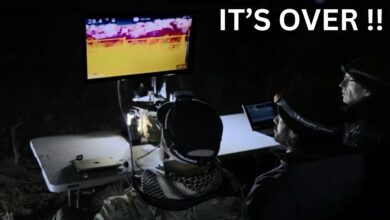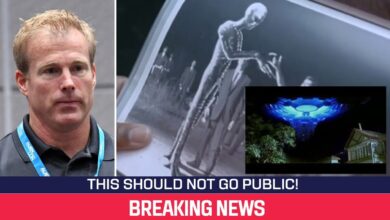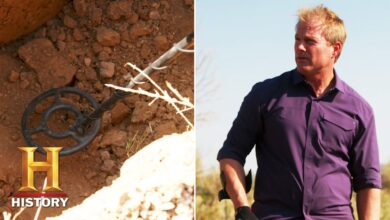Skinwalker Ranch Mystery Is Solved!
Skinwalker Ranch Mystery Is Solved!

The mysteries of Skinwalker Ranch have long fueled speculation, painstaking research, and countless sleepless nights.
For astrophysicist Dr. Travis Taylor and his team, the ranch has become a living laboratory of anomalies.
An unsettling intersection where science, legend, and unexplained phenomena collide.
But in The Secret of Skinwalker Ranch season 6, the headache has reached an entirely new level buried deep inside the mesa itself.
What began as a routine investigative drilling project designed to probe unusual underground readings has transformed into a discovery that challenges the very foundations of material science.
For over 3 years, the team has relentlessly drilled, following instruments that detected dense, anomalous masses beneath the rock layers.
These readings hinted at something massive, something unexplainable, hidden beneath the seemingly ordinary mesa.
And then the fragments appeared.
They were ceramics, but unlike anything anyone had ever seen.
At first glance, they might have passed for ordinary shards, but under scrutiny, they revealed properties that defied natural explanation: magnetic responses that alternated between attraction and repulsion, elemental compositions reminiscent of superconductors, and the uncanny ability to self-heal under the scrutiny of an electron beam.
Every test pushed the boundaries of disbelief.
The fragments contained elements like nickel, cobalt, iron, strontium, and thorium—materials that in combination suggest sophisticated engineering, not something formed through natural geological processes.
When rare earth magnets were brought close, the shards responded with unpredictable behavior, seemingly conscious of the forces acting upon them.
Travis and his team could scarcely comprehend what they were seeing. Ceramics were not supposed to do this.
Superconductivity, magnetic duality, self-repair.
These were hallmarks of technologies only dreamed of in laboratories or science fiction.
The implications were staggering.
Could these fragments represent remnants of an advanced machine, a spacecraft, or even something capable of interacting with forces humanity barely understands?
With every test, the mesa seemed to guard its secrets more jealously, as though aware of the scrutiny, yet revealing just enough to hint at its extraordinary nature.
For Travis, Brandon Fugal, and the rest of the team, the focus of their investigation had irrevocably shifted.
Gone were the days of chasing lights in the sky or puzzling over fleeting electromagnetic surges.
Now the mystery lay beneath their feet in the dense silent layers of the mesa.
What lay hidden in the rock could redefine their understanding of physics, technology, and perhaps even reality itself.
And as they paused to study the fragments, each of them could feel the weight of the question hanging in the air.
How did such advanced materials come to rest here?
And who or what placed them beneath the Utah desert?
The anomalies detected by the team’s advanced instruments did not behave like ordinary rock formations.
Every reading, every magnetic fluctuation, and every density spike hinted at something deliberately constructed, something that defied conventional geology.
The goal at first had been deceptively simple: drill, observe, and determine what lay hidden beneath the mesa.
But as the project progressed, the pursuit had unearthed something far stranger than anyone could have anticipated.
When the drill bit struck an unexpected resistance at roughly 470 ft, the team recovered fragments that immediately set hearts racing.
These were no ordinary rocks.
Held in their hands, the shards felt unnervingly lightweight yet unnaturally strong, cool to the touch, and somehow different.
At first glance, the fragments looked like ceramic.
But closer inspection revealed anomalies that stunned the scientists.
Under a microscope, the fragments told a story that challenged everything Travis Taylor thought he knew about materials.
Ordinary ceramics—clay hardened by heat—were prized for strength, durability, and heat resistance.
These, however, contained elemental signatures that had no place in standard pottery or bricks: high concentrations of rare earth metals, carbon composites, and trace elements associated with advanced technology.
Their surfaces shimmered subtly under the electron beam and when subjected to magnetic tests.
They reacted in ways that defied expectation.
Some pieces repelled magnets while others exhibited momentary attraction behavior that hinted at superconductivity or some even stranger property.
What the team held in their hands was not merely a curiosity.
It was a puzzle piece pointing to a reality that was increasingly difficult to reconcile with known science.
Each fragment seemed to whisper secrets of advanced engineering, hinting at a hidden intelligence or technology buried deep within the Utah Mesa.
Questions flooded their minds.
Who could have created such materials?
How had they come to rest in a remote desert mesa?
And perhaps most chillingly, why had they remained hidden for so long?
When Eric Bar, the ranch’s principal investigator, ran chemical analysis using a handheld X-ray fluorescence (XRF) system, the results sent ripples of disbelief through the team.
The fragments contained elements that were anything but ordinary: nickel, cobalt, iron, strontium, and even traces of thorium.
These were not the constituents of dinnerware or primitive ceramics.
They were the fingerprints of engineered high-tech materials.
Even more compelling was the presence of cobalt and nickel, elements known for their magnetic potential.
Curiosity and excitement collided as the team carefully brought rare earth magnets close to the shards.
What happened next left them speechless.
The fragments didn’t merely respond.
They danced in ways that defied explanation.
At times, they were drawn to the magnets.
At others, they repelled them, hovering or shivering in the air as if resisting the pull.
This dual magnetic behavior was unheard of in any naturally occurring material.
Ceramics, after all, are supposed to be entirely non-magnetic.
The implications were staggering.
These shards weren’t just odd.
They were engineered, possibly designed with properties that modern science struggles to replicate.
Travis Taylor’s mind raced as he considered the possibilities.
Could these fragments be exhibiting superconductivity?
The concept alone made seasoned scientists’ hearts pound.
Materials that allow electricity to flow without resistance, capable of transmitting energy perfectly, enabling technologies that today remain the stuff of dreams.
And here they were, buried deep within a remote Utah mesa, whispering secrets that could redefine what humanity thought possible.
The sheer audacity of it—the idea that such advanced materials might lie hidden for millennia—shifted the team’s perspective.
This was no longer just an anomaly.
It was a challenge, a puzzle that demanded rigorous study, cautious handling, and perhaps even a rethinking of the limits of human knowledge.
Because of their remarkable properties, superconductors lie at the heart of cutting-edge technologies—from MRI machines that peer inside the human body to maglev trains that float silently above their tracks.
Some scientists even speculate that in the near future, superconducting materials could revolutionize space propulsion or enable entirely new forms of energy storage.
The fragments recovered from the mesa displayed an elemental composition and magnetic behavior uncannily reminiscent of superconductors.
Travis Taylor could hardly hide his astonishment.
If these ceramics truly were superconducting, their very presence deep within the mesa suggested a level of technological sophistication that defied conventional explanations.
“Ceramics aren’t supposed to do this,” Travis muttered, running his fingers over a fragment as he felt the strange magnetic repulsion firsthand.
It was disorienting, almost as if the material had a mind of its own.
There are no naturally occurring substances that act this way.
This is engineered.
A cascade of questions crashed into the team’s minds.
Who could have created such materials?
And perhaps more unsettling, for what purpose?
The implications were staggering.
To probe these mysteries further, ranch owner Brandon Fugal arranged for the team to consult with Dr. Brian Patchet, a physicist at Utah Valley University.
Patchet’s expertise in material science and high-energy physics made him an ideal guide to unravel the enigma buried deep within the mesa.
With his help, the team hoped to determine whether these fragments were merely extraordinary curiosities or the remains of something far beyond anything Earth had ever produced.
Using a scanning electron microscope (SEM), the team sought to examine the ceramic fragments at an unimaginably high magnification, hoping to uncover clues hidden at the microscopic level.
What they witnessed stunned even the most seasoned scientists.
As the electron beam swept across the surface, solid material seemed to fracture into porous holes, almost as if the ceramic were alive, responding to the probing gaze.
Then, as the beam was switched off, the fragments astonishingly began to mend themselves, gradually returning to their original unbroken form.
“This stuff, it’s fixing itself,” Dr. Brian Patchet murmured in disbelief, eyes wide.
I’ve never seen anything like this in my entire career.
For Travis Taylor and the team, the implications were staggering.
A ceramic capable of self-repair under stress or observation wasn’t just remarkable—it was revolutionary.
Engineers in aerospace and advanced materials research had long dreamed of substances like this for spacecraft, satellites, and next-generation aircraft.
And yet, here it was, unearthed from deep within a Utah mesa, far removed from any laboratory.
The surprises didn’t end there.
Further chemical analysis revealed unusually high concentrations of carbon within the material.
To Travis, that discovery immediately suggested another extraordinary possibility: stealth technology.
Carbon-based composites are a cornerstone of radar-absorbing materials long used to cloak aircraft and vehicles from detection.
Could the Mesa fragments represent a far more advanced version of this technology, one buried and preserved for millennia?
Every detail pointed to the same conclusion.
What lay beneath Skinwalker Ranch was no ordinary geological oddity.
It was engineered, sophisticated, and possibly unlike anything humanity had ever encountered.
Taylor even recalled his own experiments with radar-absorbing coatings, where carefully blended carbon and aluminum compounds could render a truck virtually invisible to police radar.
Could the Mesa fragments be an advanced, far more sophisticated iteration of the same principle?
Could they be pieces of a larger structure or even a craft designed to evade detection entirely?
The implications sent a shiver through the team.
If these fragments truly combine stealth technology, superconductivity, and self-repairing properties, then the Mesa might be hiding something extraordinary—something far beyond contemporary human engineering, possibly even extraterrestrial in origin.
The revelations forced a hard reassessment of their strategy.
Up until that point, the approach had been straightforward: drill as deeply and as quickly as possible to reach whatever anomalies lurked beneath the mesa.
But now, with mounting evidence that they were dealing with highly advanced, possibly delicate materials, Brandon Fugal made a decisive call.
“We may damage the very thing we’re trying to study,” he warned, his tone measured but firm.
The team immediately agreed to pivot, abandoning aggressive drilling in favor of a meticulous archaeological-style methodology.
Every decision, every movement, now centered on preserving the integrity of the site.
The mesa was no longer just a field of anomalies.
It was a potential treasure trove of technological and scientific significance.
Every fragment, every clue demanded careful handling.
Preserving the mesa became paramount—not just for the sake of the investigation, but for the possibility that they were on the verge of uncovering something that could redefine humanity’s understanding of technology, physics, and perhaps even the universe itself.
If what lay buried within the mesa truly represented a technological artifact, then even a single careless drill strike could erase evidence of incalculable value.
The team’s approach shifted immediately, moving from aggressive probing to a meticulous, almost reverent investigation.
After years of chasing flickering lights in the sky, anomalous electromagnetic surges, and elusive craft that defied conventional physics, the focus now turned to the silent, immovable mass beneath the mesa.
Here in the dense layers of rock and soil might lie the key to Skinwalker Ranch’s deepest, most enigmatic secrets.
For Travis Taylor, the headache was no ordinary discomfort.
It was a mental weight born of confronting data that seemed to exist outside the known boundaries of science.
Each ceramic fragment they recovered raised more questions than it answered.
How had something with these properties come to rest hundreds of feet underground?
Could it be an artifact of a lost civilization buried and forgotten by time?
Or was it something far stranger, alien in origin, designed to endure centuries or millennia in silence, waiting for discovery?
The properties of the ceramics were nothing short of extraordinary.
Magnetic repulsion that shifted unpredictably, behavior reminiscent of superconductors, the eerie ability to self-heal when exposed to the electron beam of a scanning microscope.
All of these phenomena defied conventional understanding.
Even seasoned physicists were forced to reconsider the limits of material science.
These fragments were not passive geological curiosities.
They were active participants in a mystery, seemingly designed to challenge anyone who tried to understand them.
Dr. Travis Taylor, observing the behavior of the samples firsthand, felt a mixture of exhilaration and dread.
Ceramics, by their very nature, should be inert, static, predictable, and brittle.
Yet these fragments seemed alive, responding to stimuli in ways that hinted at advanced engineering.
The presence of cobalt, nickel, thorium, and unusual concentrations of carbon suggested not only magnetic and superconductive properties, but potential stealth capabilities—materials deliberately designed to manipulate electromagnetic fields, evade detection, and perhaps even interface with unknown energy systems.
Brandon Fugal, the ranch owner and the architect behind this unprecedented investigation, realized that the stakes had escalated.
This was no longer a matter of documenting anomalies.
The mesa itself might be a repository of technologies—ancient or extraterrestrial—that humanity was not prepared to understand.
To preserve the integrity of the site, Fugal mandated a new approach, one that combined archaeological care with cutting-edge scientific analysis, ensuring that nothing was damaged and every fragment, every anomaly was recorded in meticulous detail.
As the team worked, each discovery deepened the sense of wonder and unease.
Could the Mesa be more than a geological formation?
Might it act as a conduit, a transmitter, or even a gateway between realities, anchoring phenomena that had been observed for decades: blinding lights, invisible barriers, creatures that appeared and vanished at will?
Every measurement, every sample, seemed to whisper that Skinwalker Ranch was not merely a stage for strange occurrences, but a crossroads where the boundaries of science, myth, and perhaps otherworldly technology blurred.
Each fragment, each inexplicable property added weight to a growing realization.
The mesa was not simply hiding anomalies.
It was guarding secrets that could redefine humanity’s understanding of physics, material science, and the very fabric of reality.
The headache Taylor carried was no longer just personal.
It was emblematic of a truth that threatened to expand the limits of human knowledge, forcing the team to confront the staggering possibility that they were on the verge of uncovering a technology far ahead of its time—hidden in plain sight beneath the Utah desert.
And that raises perhaps the most unsettling question of all.
If such technology lies buried beneath Skinwalker Ranch, who or what put it there?
Season 6 of The Secret of Skinwalker Ranch has propelled the investigation into uncharted territory.
Previous seasons focused on UFO sightings, cattle mutilations, and strange electromagnetic anomalies, teasing at phenomena that hovered at the edge of comprehension.
But the Mesa Discovery presents something palpably different: tangible physical evidence of advanced technology.
The ranch has long been a nexus where folklore and science intertwine.
A place where stories of shadowy creatures, vanishing lights, and unexplained phenomena blend seamlessly with rigorous investigation.
Yet the ceramic fragments, with their reproducible, measurable properties, elevate the mystery from anecdote to undeniable data.
These are materials that behave in ways no naturally occurring substance should: repelling and attracting magnets, exhibiting superconductive-like behavior, self-healing under a scanning electron microscope, and containing elements often associated with advanced engineering.
This is not speculation.
This is evidence demanding explanation.
For Brandon Fugal and his team, the implications are staggering.
Skinwalker Ranch is no longer merely a backdrop for strange tales or a curiosity for paranormal enthusiasts.
It is a site of genuine scientific importance, a laboratory buried in the Utah desert where anomalies manifest not just in stories or sightings, but in hard, measurable reality.
Fugal himself has remarked that after 8 years of meticulous investigation, this moment represents a critical turning point, one that could reshape the trajectory of the research entirely.
Dr. Travis Taylor’s headache is emblematic of the broader challenge facing the team.
The strain of confronting data that should not exist, of holding evidence that defies current scientific understanding.
It is a headache born not of fatigue, but of awe, of grappling with the enormity of questions that have no ready answers.
Every measurement, every fragment recovered from the mesa, forces the team to reconsider what is possible.
The boundaries between natural and artificial, myth and reality, known science and the unknown.
And as the investigation presses forward, one truth becomes increasingly clear: Skinwalker Ranch is far more than a place of anomalies.
It is a doorway into questions that may stretch the very limits of human understanding.
The ceramic fragments from the mesa are magnetic when they shouldn’t be.
They behave in ways that hint at superconductivity, seemingly defying the known laws of physics.
Under the scrutiny of a scanning electron microscope, the fragments repair themselves almost as if alive, closing microscopic cracks and pores as though reacting to observation.
Their chemical composition reveals elements often associated with advanced stealth technology: nickel, cobalt, thorium, and carbon in ratios that suggest materials engineered to manipulate energy and electromagnetic waves in ways modern science barely comprehends.
Each discovery alone would electrify any laboratory.
Yet here in the barren, windswept Utah desert, they converge in a single chilling realization.
The mesa hides something extraordinary, something that may not belong entirely to this world.
Could these fragments be remnants of lost human ingenuity or evidence of technologies far beyond earthly design?
Could they represent a machine, a gateway, or even a tool to manipulate unseen forces?
The implications of these findings ripple through the minds of Travis Taylor and his colleagues.
If superconducting ceramics exist here, buried hundreds of feet below the surface, what unseen power might they be channeling?
Could the mesa itself act as a conductor, a transmitter, or even a dimensional bridge?
For decades, eyewitnesses have reported sudden electromagnetic surges, invisible barriers, and strange craft that vanish into thin air.
Now, the ceramic fragments give a physical anchor to phenomena that have long defied explanation.
The decision to halt drilling speaks volumes.
The team recognizes that this is no longer a hunt for anomalies.
It is a delicate excavation of something unprecedented.
Every strike of the drill, every vibration of the ground, risks destroying evidence that could rewrite our understanding of materials, science, physics, and even reality itself.
The mesa, once a distant curiosity, has become a living puzzle, challenging the boundaries of human knowledge.
As the sun sets behind the jagged ridges, casting the desert in deep amber shadows, the fragments glint in the fading light—tiny yet monumental witnesses to secrets long hidden.
For Travis Taylor, Brandon Fugal, and the team, the question looms larger than ever.
What lies beneath the surface?
Who or what placed it here?
And how far does this hidden technology reach?
Not just across the mesa, but across time, space, and understanding itself.
And as season 6 unfolds, viewers will watch closely, holding their breath as Travis Taylor and his team delve deeper into the Mesa’s mysteries.
Will they finally unravel the riddle?
Or will the mesa continue to guard its secrets with silent, impenetrable authority?
Some researchers now speculate that the materials hidden within the mesa may not only serve an advanced technological function, but also interact with the invisible forces long reported at Skinwalker Ranch.
For decades, eyewitnesses have described sudden electromagnetic surges that flicker lights and disable equipment, GPS systems that wander like lost travelers, and invisible barriers that seem to materialize out of nothing, obstructing or guiding movement in ways that defy logic.
Could the superconducting ceramics buried beneath the mesa be part of a larger energy network, a hidden system capable of manipulating these unseen fields?
If so, the mesa may not simply be a geological formation.
It could be a transmitter, a stabilizer, or even a gateway bridging dimensions.
Theories of space gates and interdimensional portals at Skinwalker Ranch have long been dismissed as fringe speculation.
Yet, the discovery of engineered self-healing magnetic ceramics lends these ideas a new weight.
Suddenly, stories once relegated to folklore gain a strange, unsettling plausibility.
Even the ancient legends of the Ute tribe take on a new resonance.
They speak of forbidden ground, places where spirits and creatures pass between worlds, where the boundaries of reality are thin and permeable.
Could it be that these legends were never mere stories, but warnings?
Warnings of forces and technologies hidden just beneath the surface, waiting to be understood—or perhaps never fully revealed.
As the sun dips behind the mesas, casting long shadows across the desert, the team’s instruments hum and pulse, responding to the anomalies that lurk unseen.
Every reading, every fragment, every flicker of energy is a clue, a whisper from a deeper reality.
For Travis, Brandon Fugal, and their colleagues, the line between science and myth has blurred.
And for viewers, the unfolding investigation promises a season of tension, wonder, and revelations that may challenge everything we think we know about the world beneath and beyond our feet.
In modern times, scientists studying space-time physics have speculated that superconductors might do more than transmit electricity.
They could manipulate magnetic fields in ways that subtly affect gravity itself.
If the AESA ceramics truly possess superconductive properties, then their significance extends far beyond powering machines.
They might serve as anchors for a doorway through time and space, a mechanism by which the very fabric of reality is bent or stabilized.
Could this be the hidden reason why witnesses at Skinwalker Ranch report craft that defy physics, lights that appear and vanish at impossible speeds, and creatures that seem to ignore the laws of gravity altogether?
The strangeness doesn’t stop at technology.
Reports of mystical creatures add a layer of profound unease.
Enormous wolves said to be impervious to bullets, shadowy figures that slip through darkness, and unidentified aerial entities moving in ways that confound explanation have been documented at the ranch for decades.
To skeptics, these are exaggerations or hoaxes.
To others, they are glimpses of a hidden reality.
A reality in which the laws of nature are subtly altered by forces unseen.
Some theorists suggest that these beings are not merely figments of folklore or the collective imagination.
They could be travelers, visitors, slipping through cracks in reality created or regulated by the high-tech materials buried beneath the mesa.
If that is the case, then the superconducting self-healing ceramics Travis Taylor’s team has uncovered may be far more than inert fragments.
They could be remnants of an ancient or alien installation—a sophisticated system designed to monitor, filter, or even control who or what can cross into our world.
The implications are staggering.
A hidden architecture of power beneath the Utah desert, quietly shaping phenomena that have mystified humanity for generations.
With each new discovery, the boundary between science and legend at Skinwalker Ranch becomes ever more tenuous.
What lies beneath the mesa may not just be technological.
It may be a key to understanding dimensions we have barely begun to perceive and forces that humanity is only just learning to confront.
The conspiracies surrounding Skinwalker Ranch run far deeper than most imagine.
For decades, the US government quietly funneled millions of dollars into covert research on the property, often through programs linked to the Pentagon, aerospace contractors, and even classified projects at nearby military installations.
These programs were not publicly acknowledged, and documentation is scarce, fueling speculation that whatever is buried beneath the mesa or hidden in plain sight across the ranch was considered a matter of national or even global significance.
Why devote such enormous resources to a remote stretch of Utah desert, unless something of profound importance lay hidden there?
Some researchers suggest the answer lies not in what is visible, but in the invisible currents that seem to thread the land itself.
One theory posits that Skinwalker Ranch sits at a convergence point of Earth’s timelines, a rare nexus where past, present, and future do not simply coexist.
They intersect.
In such zones, the normal flow of causality could become unstable, allowing phenomena or entities from other eras—or perhaps other dimensions—to seep into our reality.
Strange electromagnetic surges, abrupt shifts in gravity, and GPS distortions reported over decades could be the surface-level signatures of deeper, more complex manipulations of space-time.
If true, this could explain not only the strange craft and glowing light seen overhead, but also the inexplicable creatures described in local folklore.
Enormous wolves impervious to bullets, shadowy beings that vanish into thin air, and entities that appear only to witnesses who approach the unknown with a mixture of fear and awe.
The discovery of superconducting, self-healing ceramics buried deep within the mesa adds yet another layer to this mystery.
These materials could theoretically be part of a system capable of manipulating energy fields, stabilizing wormholes, or even bending localized space-time.
Ancient folklore from the Ute tribe speaks of forbidden ground where spirits and creatures pass between worlds.
Could modern science now be uncovering the material evidence of what indigenous peoples recognized long ago?
If so, the mesa might be more than a geological curiosity.
It could be a deliberately engineered focal point designed to regulate or control the movement of forces and entities across dimensions.
The stakes are staggering.
What lies beneath the surface may not be a simple artifact or geological anomaly, but a relic of advanced technology—human, alien, or something else entirely—carefully concealed, watched, and perhaps even harnessed by those who understand its power.
If the mesa contains artifacts capable of manipulating time itself, then perhaps the government has known far more than they’ve ever admitted.
For Travis Taylor and his colleagues, these questions hover like storm clouds over every new discovery, darkening even the most straightforward scientific observations.
The ceramic fragments are no longer just curiosities.
They are keys, fragile yet profound, pointing toward a much larger and stranger picture of reality.
Each piece seems to whisper of technologies and forces that defy human understanding.
Are they remnants of a spacecraft lost to history?
Fragments of a dimensional gate, or components of a machine capable of harnessing the unseen energies of Earth itself?
Every test, every magnetic anomaly, every self-healing crack in the ceramic raises more questions than answers.
Could this material, buried for untold centuries, be evidence that human science has only begun to comprehend?
Or perhaps that someone or something has long been working at the edge of knowledge we cannot yet imagine?
And if the mesa truly acts as a conduit for forces beyond our normal perception, then the line between myth and reality begins to blur.
Ancient youth legends, modern sightings of strange craft and creatures, and secret government programs may not be separate threads at all, but intertwined strands in a single intricate tapestry of mystery.
The implications are staggering.
If the mesa holds mechanisms capable of bending time, manipulating energy, or controlling the invisible currents of our world, then exploring it is no longer a matter of curiosity—it becomes an encounter with the limits of human comprehension.
For Travis and his team, each discovery is a revelation, each anomaly a challenge, and each fragment a reminder that the universe may be far stranger and far more technologically advanced than humanity has ever dared to imagine.
The Mesa secrets are not just artifacts of the past.
They are provocations to the future, daring science, myth, and even conspiracy to converge, and forcing all who investigate to confront the unsettling possibility that understanding them could reshape the very way we perceive reality.








